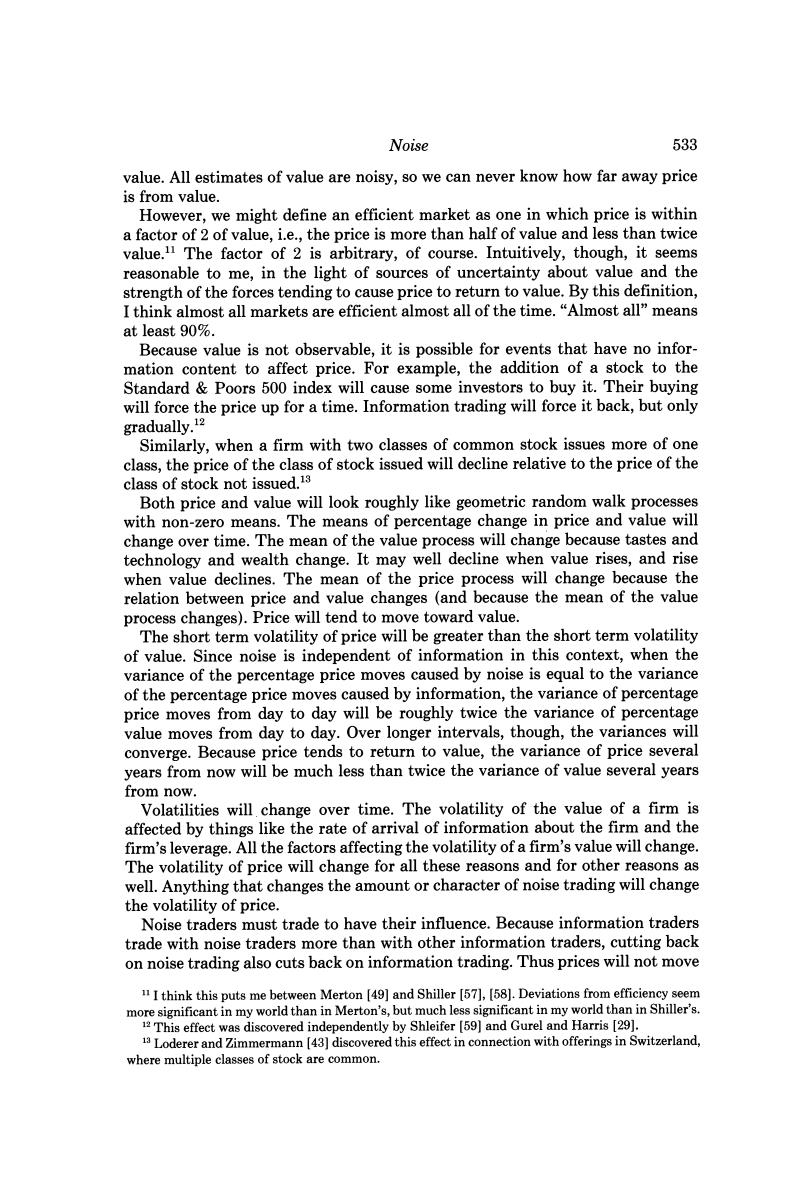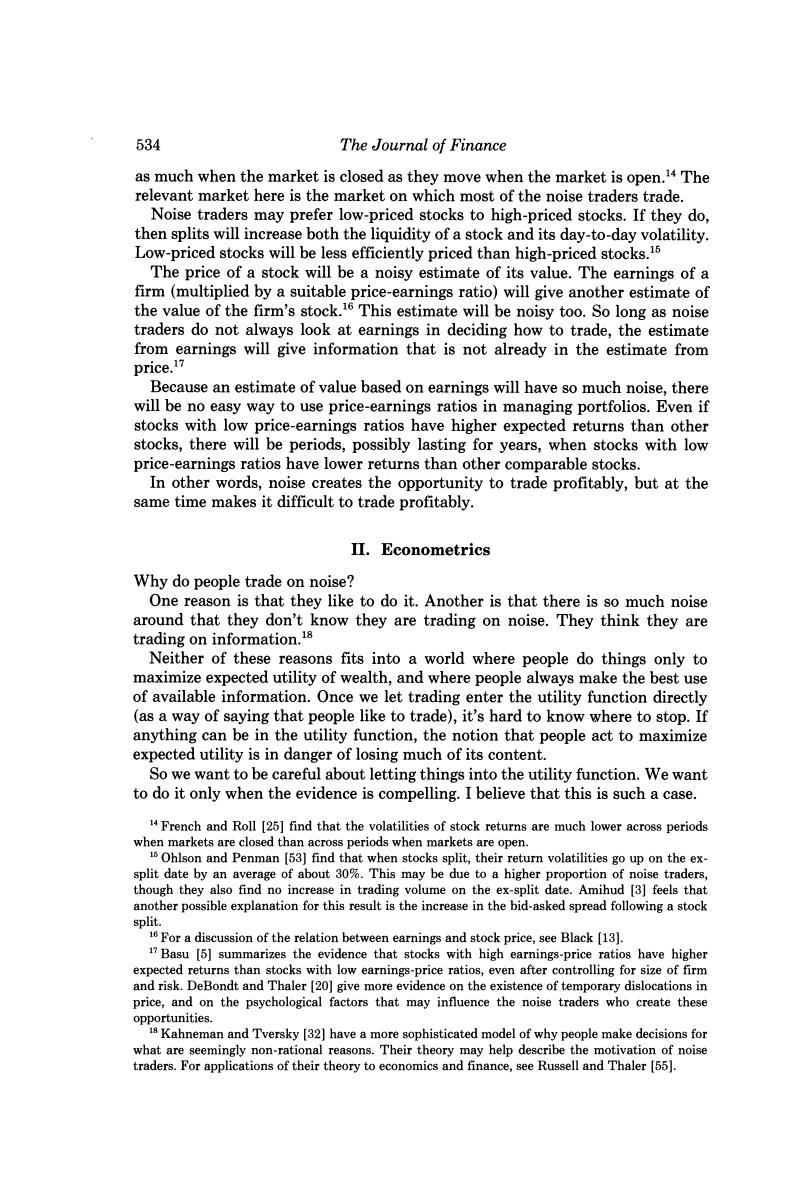
Noise 533 value.All estimates of value are noisy,so we can never know how far away price is from value. However,we might define an efficient market as one in which price is within a factor of 2 of value,i.e.,the price is more than half of value and less than twice value.11 The factor of 2 is arbitrary,of course.Intuitively,though,it seems reasonable to me,in the light of sources of uncertainty about value and the strength of the forces tending to cause price to return to value.By this definition, I think almost all markets are efficient almost all of the time."Almost all"means at least 90%. Because value is not observable,it is possible for events that have no infor- mation content to affect price.For example,the addition of a stock to the Standard Poors 500 index will cause some investors to buy it.Their buying will force the price up for a time.Information trading will force it back,but only gradually.12 Similarly,when a firm with two classes of common stock issues more of one class,the price of the class of stock issued will decline relative to the price of the class of stock not issued.13 Both price and value will look roughly like geometric random walk processes with non-zero means.The means of percentage change in price and value will change over time.The mean of the value process will change because tastes and technology and wealth change.It may well decline when value rises,and rise when value declines.The mean of the price process will change because the relation between price and value changes (and because the mean of the value process changes).Price will tend to move toward value. The short term volatility of price will be greater than the short term volatility of value.Since noise is independent of information in this context,when the variance of the percentage price moves caused by noise is equal to the variance of the percentage price moves caused by information,the variance of percentage price moves from day to day will be roughly twice the variance of percentage value moves from day to day.Over longer intervals,though,the variances will converge.Because price tends to return to value,the variance of price several years from now will be much less than twice the variance of value several years from now. Volatilities will change over time.The volatility of the value of a firm is affected by things like the rate of arrival of information about the firm and the firm's leverage.All the factors affecting the volatility of a firm's value will change. The volatility of price will change for all these reasons and for other reasons as well.Anything that changes the amount or character of noise trading will change the volatility of price. Noise traders must trade to have their influence.Because information traders trade with noise traders more than with other information traders,cutting back on noise trading also cuts back on information trading.Thus prices will not move 1I think this puts me between Merton [49]and Shiller [57],[58].Deviations from efficiency seem more significant in my world than in Merton's,but much less significant in my world than in Shiller's. 1This effect was discovered independently by Shleifer [59]and Gurel and Harris [29]. 13 Loderer and Zimmermann [43]discovered this effect in connection with offerings in Switzerland, where multiple classes of stock are common

534 The Journal of Finance as much when the market is closed as they move when the market is open.14 The relevant market here is the market on which most of the noise traders trade. Noise traders may prefer low-priced stocks to high-priced stocks.If they do, then splits will increase both the liquidity of a stock and its day-to-day volatility. Low-priced stocks will be less efficiently priced than high-priced stocks.15 The price of a stock will be a noisy estimate of its value.The earnings of a firm(multiplied by a suitable price-earnings ratio)will give another estimate of the value of the firm's stock.16 This estimate will be noisy too.So long as noise traders do not always look at earnings in deciding how to trade,the estimate from earnings will give information that is not already in the estimate from price.17 Because an estimate of value based on earnings will have so much noise,there will be no easy way to use price-earnings ratios in managing portfolios.Even if stocks with low price-earnings ratios have higher expected returns than other stocks,there will be periods,possibly lasting for years,when stocks with low price-earnings ratios have lower returns than other comparable stocks. In other words,noise creates the opportunity to trade profitably,but at the same time makes it difficult to trade profitably. IⅡ.Econometrics Why do people trade on noise? One reason is that they like to do it.Another is that there is so much noise around that they don't know they are trading on noise.They think they are trading on information.18 Neither of these reasons fits into a world where people do things only to maximize expected utility of wealth,and where people always make the best use of available information.Once we let trading enter the utility function directly (as a way of saying that people like to trade),it's hard to know where to stop.If anything can be in the utility function,the notion that people act to maximize expected utility is in danger of losing much of its content. So we want to be careful about letting things into the utility function.We want to do it only when the evidence is compelling.I believe that this is such a case. 14French and Roll [25]find that the volatilities of stock returns are much lower across periods when markets are closed than across periods when markets are open. 1Ohlson and Penman [53]find that when stocks split,their return volatilities go up on the ex- split date by an average of about 30%.This may be due to a higher proportion of noise traders, though they also find no increase in trading volume on the ex-split date.Amihud [3]feels that another possible explanation for this result is the increase in the bid-asked spread following a stock split. 1 For a discussion of the relation between earnings and stock price,see Black[13]. 1Basu [5]summarizes the evidence that stocks with high earnings-price ratios have higher expected returns than stocks with low earnings-price ratios,even after controlling for size of firm and risk.DeBondt and Thaler [20]give more evidence on the existence of temporary dislocations in price,and on the psychological factors that may influence the noise traders who create these opportunities. 1Kahneman and Tversky [32]have a more sophisticated model of why people make decisions for what are seemingly non-rational reasons.Their theory may help describe the motivation of noise traders.For applications of their theory to economics and finance,see Russell and Thaler [55]